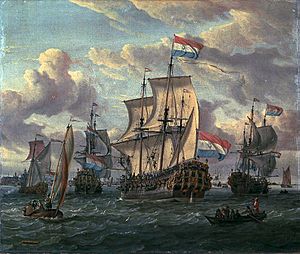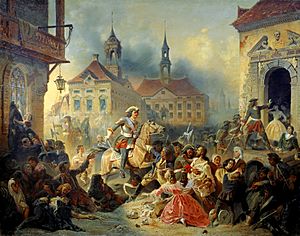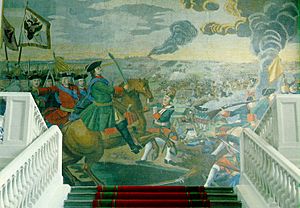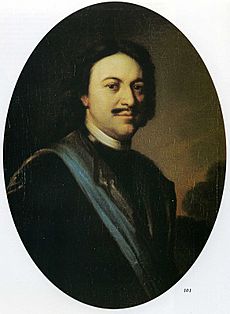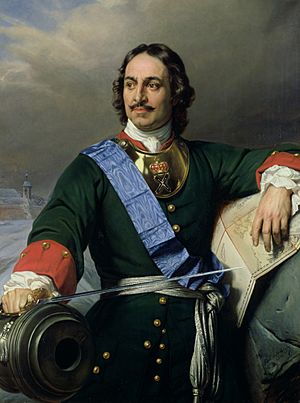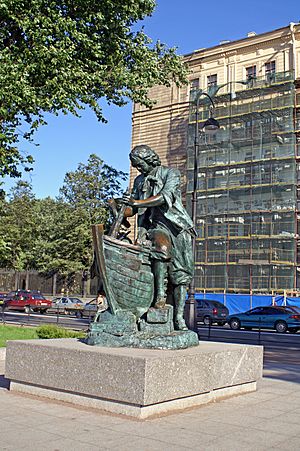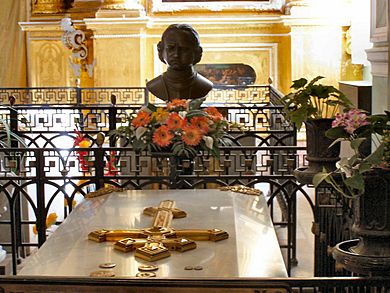Peter the Great facts for kids
Quick facts for kids Peter I |
|||||
|---|---|---|---|---|---|
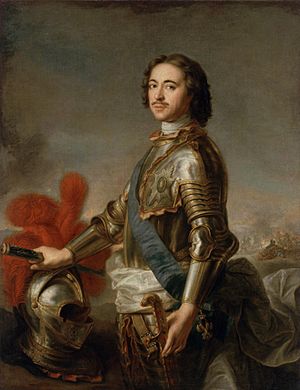
Portrait by Jean-Marc Nattier, after 1717
|
|||||
| Tsar / Emperor of Russia | |||||
| Reign | 7 May 1682 – 8 February 1725 | ||||
| Coronation | 25 June 1682 | ||||
| Predecessor | Feodor III | ||||
| Successor | Catherine I | ||||
| Co-monarch | Ivan V (1682–1696) | ||||
| Regent | Sophia Alekseyevna (1682–1689) | ||||
| Born | 9 June 1672 Moscow, Tsardom of Russia |
||||
| Died | 8 February 1725 (aged 52) Saint Petersburg, Russian Empire |
||||
| Burial | Peter and Paul Cathedral | ||||
| Consort | |||||
| Issue among others |
|
||||
|
|||||
| House | Romanov | ||||
| Father | Alexis of Russia | ||||
| Mother | Natalya Naryshkina | ||||
| Religion | Russian Orthodoxy | ||||
| Signature | |||||
Peter I (June 9, 1672 – February 8, 1725), often called Peter the Great, was a powerful Russian ruler. He led the Tsardom of Russia from 1682 and later the Russian Empire until his death in 1725. For a time, he ruled alongside his older half-brother, Ivan V.
Peter is famous for modernizing Russia. He helped turn it into a major European power. He won important wars, gaining access to the Azov and Baltic Seas. This helped him create the Imperial Russian Navy. He also ended Sweden's control of the Baltic region.
Peter led a big cultural change in Russia. He replaced old traditions with modern, scientific, and Western ideas. His changes had a lasting effect on Russia's government. In 1721, he took the title of Emperor instead of Tsar. He also founded and developed the city of Saint Petersburg, which became Russia's capital until 1918.
The first Russian university, Saint Petersburg State University, was started in 1724, a year before Peter died.
Contents
Peter's Early Life
Peter was named after the apostle. He was described as a healthy baby with dark eyes and reddish-brown hair. His father, Tsar Alexis of Russia, arranged for him to have several teachers. These included Nikita Zotov, Patrick Gordon, and Paul Menesius.
When his father died in 1676, Peter's older half-brother, Feodor III of Russia, became Tsar. Feodor was often sick. After Feodor died in 1682 without children, there was a disagreement over who should rule. Peter's other half-brother, Ivan V of Russia, was next in line. However, Ivan was also often ill and not strong enough to rule alone.
So, a council of Russian nobles, the Boyar Duma, chose 10-year-old Peter as Tsar. His mother became his regent, meaning she would rule for him until he was old enough.
This decision was presented to the people of Moscow and approved. But Sophia, one of Peter's half-sisters, led a rebellion in 1682. During this time, some of Peter's relatives and friends were killed. Peter saw some of these violent events.
The rebellion led to Peter and Ivan being named joint Tsars. Ivan was considered the senior ruler. Sophia then became the main ruler, or regent, for seven years. She sat behind a special two-seated throne used by Peter and Ivan. From there, she would listen and secretly give Peter advice when he talked to nobles. This special throne can still be seen in the Kremlin Armoury in Moscow.
Peter didn't worry much about others ruling for him. He enjoyed hobbies like shipbuilding and sailing. He also played with his toy army, staging mock battles. His mother wanted him to be more serious. So, she arranged his marriage to Eudoxia Lopukhina in 1689. This marriage was not happy. Ten years later, Peter made his wife become a nun, ending their marriage.
By the summer of 1689, Peter, then 17, decided to take power from Sophia. Her rule had weakened after two failed wars against the Crimean Khanate. Sophia tried to get the Streltsy (Russia's elite military) to support her. But Peter was warned and escaped to a strong monastery. There, he slowly gathered people who supported him. Sophia was eventually overthrown. Peter and Ivan V continued as co-tsars. Peter forced Sophia to join a convent, where she lost her royal status.
Peter's mother, Natalya Naryshkina, held the real power in Russia. It was only after she died in 1694 that Peter, at age 22, became an independent ruler. Ivan V was still officially a co-ruler but had no real power. Peter became the sole ruler when Ivan died in 1696.
Peter grew to be very tall, about 6 feet 8 inches. This was unusual for his time. He had small hands and feet, and narrow shoulders for his height. He also had a small head for his tall body. Peter had noticeable facial twitches and may have had a mild form of epilepsy.
When he was young, Peter became friends with foreigners like Patrick Gordon and Franz Lefort. He often visited Moscow's German Quarter, where he met his Dutch girlfriend, Anna Mons.
Peter's Reign and Reforms
Peter made big changes to modernize Russia. He was greatly influenced by advisors from Western Europe. He reorganized the Russian army to be more like European armies. He also dreamed of making Russia a strong naval power. Many people in Russia opposed his changes. But Peter put down rebellions against his rule, including those by the Streltsy and the Bulavin Rebellion.
Peter brought social changes by making his court wear French and Western clothes. He also required officials and soldiers to shave their beards and wear modern styles. To encourage this, he introduced a tax for long beards in 1698.
He wanted his family members to marry other European royals. He arranged for his niece, Anna Ivanovna, to marry Frederick William, Duke of Courland. He used this wedding to show off his new capital, St Petersburg. He had hired Italian and German architects to design Western-style palaces and buildings there.
Peter also started an effort to industrialize Russia. This was slow but successful. Russia's main industries were mining and lumber. By the end of his rule, Russia exported more iron than any other country.
To improve Russia's position on the seas, Peter wanted more ports. At the time, Russia only had access to the White Sea at Arkhangelsk. The Baltic Sea was controlled by Sweden. The Black Sea and Caspian Sea were controlled by the Ottoman Empire and Safavid Empire.
Peter tried to gain control of the Black Sea. This meant fighting the Tatars and the Ottoman Sultan. His main goal was to capture the Ottoman fortress of Azov. In 1695, Peter tried to take Azov, but he failed.
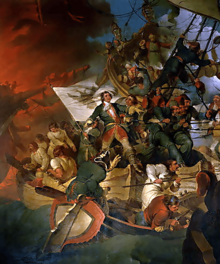
Peter returned to Moscow and began building a large navy. In 1696, he launched about thirty ships against the Ottomans. He captured Azov that July. In 1698, Peter officially created the first Russian Navy base at Taganrog on the Sea of Azov.
The Grand Embassy
Peter knew Russia couldn't fight the Ottoman Empire alone. In 1697, he traveled to Western Europe for 18 months with a large group of Russians. This trip was called the "Grand Embassy." He used a fake name to avoid formal events. However, he was much taller than most people, so important figures usually knew who he was. One goal was to get help from European rulers. But Peter's hopes were not met. France was an ally of the Ottoman Sultan. Austria wanted peace in the east. Also, European countries were busy with the War of the Spanish Succession.
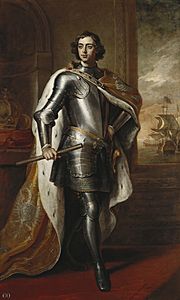
The "Grand Embassy" continued. In the Netherlands, Peter learned a lot about Western Europe. He studied shipbuilding in Zaandam and Amsterdam. He visited the De Wilde family, who had a famous art collection. Peter later bought their collection.
With help from Amsterdam's mayor, Peter got hands-on experience at the world's largest shipyard. He helped build a ship called Peter and Paul. During his stay, he hired many skilled workers like builders, shipwrights, and sailors. Peter later used this knowledge to build Russia's navy. He also visited a surgeon who taught him how to pull teeth.
In England, Peter met King William III. He visited Greenwich and Oxford. He also saw a Royal Navy Fleet Review at Deptford. He studied English city-building techniques, which he later used for Saint Petersburg.
Peter's trip was cut short in 1698. He had to rush home because of a rebellion of the Streltsy. The rebellion was easily stopped before he even arrived. But Peter dealt with the rebels very strictly. Over a thousand rebels were punished and executed. Their bodies were displayed publicly as a warning. The Streltsy were disbanded. Peter's half-sister Sophia, whom they wanted to put on the throne, was forced to become a nun.
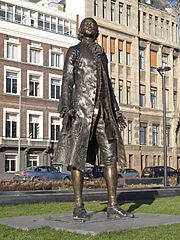
Peter's visits to the West convinced him that European customs were better than Russian traditions in many ways. He ordered all his courtiers and officials to wear European clothes and cut their long beards. This upset the Boyars, who loved their beards. Those who wanted to keep their beards had to pay a yearly beard tax. Peter also tried to stop arranged marriages among nobles. He thought they were old-fashioned and led to problems.
In 1699, Peter changed the date of the New Year celebration from September 1 to January 1. Traditionally, years were counted from the supposed creation of the World. After Peter's changes, they were counted from the birth of Christ, using the Julian Calendar. So, the year 7207 in the old Russian calendar became 1700.
The Great Northern War
Peter made peace with the Ottoman Empire, keeping the Azov fortress. Then, he focused on gaining control of the Baltic Sea. This area had been controlled by the Swedish Empire for 50 years. Peter declared war on Sweden, which was led by the young King Charles XII. Sweden was also fighting against Denmark–Norway, Saxony, and the Polish–Lithuanian Commonwealth.
Russia was not ready to fight the Swedes. Their first attempt to take the Baltic coast failed badly at the Battle of Narva in 1700. Charles XII attacked quickly during a snowstorm. After this battle, Charles XII decided to focus on the Polish–Lithuanian Commonwealth. This gave Peter time to rebuild the Russian army.
While the Poles fought the Swedes, Peter founded the city of Saint Petersburg in 1703. It was in Ingria, a Swedish province he had captured. He named it after his patron saint, Saint Peter. He banned building stone buildings outside Saint Petersburg. This was so all stonemasons would work on the new city. Peter moved the capital to St. Petersburg in 1703. He and Catherine lived in a simple log cabin there. Between 1713 and 1918, Saint Petersburg was the capital of imperial Russia.
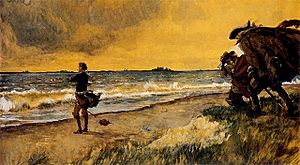
After some defeats, Polish King Augustus II the Strong gave up his throne in 1706. Swedish King Charles XII then turned his attention to Russia, invading in 1708. Charles defeated Peter at Golovchin in July. But in the Battle of Lesnaya, Charles lost for the first time when Peter defeated Swedish reinforcements. Without this help, Charles had to give up his plan to march on Moscow.
Charles XII refused to retreat. Instead, he invaded Ukraine. Peter pulled his army back, using a "scorched earth" tactic. They destroyed anything that could help the Swedes. Without local supplies, the Swedish army had to stop its advance in the winter of 1708–1709. In the summer of 1709, they tried again to capture Russian-ruled Ukraine. This led to the Battle of Poltava on June 27. This battle was a huge defeat for the Swedes. It ended Charles' campaign in Ukraine and forced him to seek safety in the Ottoman Empire. Russia had defeated one of the world's best armies. This victory changed how people viewed Russia's military strength. In Poland, Augustus II became King again.
Peter then attacked the Ottoman Empire, starting the Russo-Turkish War of 1710. Peter's campaign was a disaster. In the Treaty of the Pruth, he had to give back the Black Sea ports he had captured in 1697. In return, the Sultan expelled Charles XII.
The Ottomans called Peter Mad Peter because he was willing to sacrifice many of his soldiers in war.
Normally, the Boyar Duma would have ruled when Peter was away. But Peter didn't trust the boyars. So, he got rid of the Duma and created a Senate of ten members. The Senate was the highest government body. It oversaw all legal, financial, and administrative matters. It was first created for when the ruler was away, but it became a permanent body. A special official, the Ober-Procurator, connected the ruler and the Senate. Peter called him "the sovereign's eye." No Senate decision could take effect without his signature. The Senate became very important in Imperial Russia.
Peter's armies in the north took the Swedish province of Livonia (now parts of Latvia and Estonia). They pushed the Swedes into Finland. In 1714, the Russian fleet won the Battle of Gangut. Most of Finland was occupied by the Russians.
In 1716 and 1717, Peter visited the Netherlands again and traveled to France. He got many books and suggested a marriage between his daughter and King Louis XV. Peter also got help from the Electorate of Hanover and the Kingdom of Prussia.
The Tsar's navy became strong enough to attack Sweden. Charles XII still refused to give up. Peace was only possible after he died in battle in 1718. By 1720, Sweden made peace with all powers except Russia. In 1721, the Treaty of Nystad ended the Great Northern War. Russia gained Ingria, Estonia, Livonia, and part of Karelia. In return, Russia paid two million Riksdaler and gave back most of Finland. Peter kept some Finnish lands near Saint Petersburg, which he had made his capital in 1712.
Later Years and Legacy
Peter's final years involved more reforms in Russia. On October 22, 1721, after making peace with Sweden, he was officially named Emperor of All Russia. Some suggested he take the title Emperor of the East, but he refused. Gavrila Golovkin, the State Chancellor, was the first to add "the Great, Father of His Country, Emperor of All the Russias" to Peter's title. This happened after a speech by the archbishop of Pskov in 1721. Peter's imperial title was recognized by some European rulers, but not all. Many feared that Peter would claim authority over them.
In 1717, Alexander Bekovich-Cherkassky led the first Russian military trip into Central Asia. This trip ended badly, with the entire force being defeated.
After 1718, Peter created "colleges" to replace the old government agencies. These included departments for foreign affairs, war, navy, and justice. Each college had a president, vice-president, and other officials. Peter preferred groups of people to make decisions, with majority vote, to keep checks on each other.
In 1722, Peter created a new system called the Table of Ranks. Before, a person's importance was based on their birth. To reduce the power of the Boyars, Peter ordered that importance should be based on merit and service to the Emperor. The Table of Ranks stayed in use until the Russian monarchy ended in 1917.
Peter believed that all noble children should get an early education, especially in science. So, in 1714, he ordered that all Russian noble children aged 10 to 15 must learn basic math and geometry. They would be tested on these subjects.
The Persian Safavid Empire to the south was weakening. Peter took advantage of this. He launched the Russo-Persian War of 1722–1723. This war greatly increased Russian influence in the Caucasus and Caspian Sea region. It also stopped the Ottoman Empire from gaining land there. Russia captured many areas, and the Safavids had to give up territory. However, within twelve years, these lands were given back to Persia.
Peter introduced new taxes to pay for improvements in Saint Petersburg. He replaced the land tax and household tax with a poll tax. This new tax was paid by everyone, including serfs and poor people. In 1725, the Peterhof palace near Saint Petersburg was finished. Peterhof, meaning "Peter's Court" in Dutch, was a grand home known as the "Russian Versailles."
Illness and Death
In the winter of 1723, Peter, who was never very healthy, started having problems with his urinary tract and bladder. In the summer of 1724, he had surgery and stayed in bed until autumn. In early October, feeling better, Peter began inspecting various projects.
According to one story, in November, Peter saw soldiers drowning near shore. He waded into the icy water to rescue them. This cold water rescue is said to have made his bladder problems worse and led to his death. However, some historians doubt this story.
In early January 1725, Peter became very ill again. Legend says that before he lost consciousness, Peter tried to write a note that read: "Leave all to ..." He then asked for his daughter Anna to be called.
Peter died on February 8, 1725, at fifty-two years old. An autopsy showed his bladder was badly infected. He is buried in Saints Peter and Paul Cathedral, Saint Petersburg, Russia.
Religion and the Church
Peter grew up in the Russian Orthodox faith. However, he didn't have much respect for the Church leaders. He kept the Church under strict government control. The traditional head of the Church was the Patriarch of Moscow. In 1700, when this position became empty, Peter refused to name a new Patriarch. He allowed a deputy to handle the duties. Peter didn't want the Patriarch to have more power than the Tsar.
So, Peter's Church reform of Peter the Great got rid of the Patriarchate. He replaced it with a Holy Synod, which was a council of ten clergymen. This Synod was controlled by a government official called a Procurator. The Tsar appointed all bishops.
Peter also made a law that no Russian man could join a monastery before the age of fifty. He felt that too many able men were becoming monks when they could be serving in his new army.
Becoming a priest was not a popular career choice for upper-class people. Most parish priests were sons of priests and were not well-educated or paid. Monks in monasteries had a slightly higher status. Politically, the Church had little power.
Peter's Family
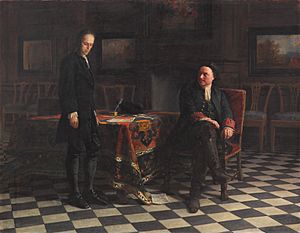
Peter the Great had two wives and fourteen children. Only three of his children lived to adulthood. Peter's mother chose his first wife, Eudoxia Lopukhina, in 1689. This was a common tradition for the Romanov family.
After his European trip in 1698, Peter wanted to end his unhappy marriage. He divorced the Tsaritsa and forced her to join a convent. Eudoxia had given Peter three children, but only one, Alexei Petrovich, Tsarevich of Russia, lived past childhood.
Peter later took Marta Helena Skowrońska, a Polish-Lithuanian peasant, as his girlfriend. She converted to the Russian Orthodox Church and took the name Catherine. They secretly married between 1702 and 1704. Peter valued Catherine and married her officially in 1712.
His oldest child and heir, Alexei, was suspected of planning to overthrow Peter. Alexei was questioned and confessed under pressure. He was found guilty and sentenced to death. Alexei died in prison, likely from injuries during his questioning. Alexei's mother, Eudoxia, was also punished.
In 1724, Peter had his second wife, Catherine, crowned as Empress. However, he remained the actual ruler of Russia. All of Peter's male children had died.
Children
Peter had fourteen children with his two wives. This included three sons named Pavel and three sons named Peter, all of whom died as babies. Only three of his children lived to be adults: Alexei, Anna Petrovna, and Elizabeth. He had only two grandchildren: Peter II and Peter III.
| Name | Birth | Death | Notes |
|---|---|---|---|
| By Eudoxia Lopukhina | |||
| Alexei Petrovich, Tsarevich of Russia | February 18, 1690 | June 26, 1718, age 28 | Married 1711, Charlotte Christine of Brunswick-Lüneburg; had children |
| Alexander Petrovich | October 13, 1691 | May 14, 1692, age 7 months | |
| Pavel Petrovich | 1693 | 1693 | |
| By Catherine I | |||
| Peter Petrovich | 1704 | in infancy | Born and died before his parents' official marriage |
| Paul Petrovich | 1705 | in infancy | Born and died before his parents' official marriage |
| Catherine Petrovna | December 1706 | June 1708, age 18 months | Born and died before her parents' official marriage |
| Anna Petrovna | January 27, 1708 | May 15, 1728, age 20 | Married 1725, Karl Friedrich, Duke of Holstein-Gottorp; had children |
| Yelisaveta Petrovna, later Empress Elizabeth |
December 29, 1709 | January 5, 1762, age 52 | Reportedly married 1742, Alexei Grigorievich, Count Razumovsky; no children |
| Maria Petrovna | March 20, 1713 | May 27, 1715, age 2 | |
| Margarita Petrovna | September 19, 1714 | June 7, 1715, age 9 months | |
| Peter Petrovich | November 15, 1715 | April 19, 1719, age 3 | |
| Pavel Petrovich | January 13, 1717 | January 14, 1717, age 1 day | |
| Natalia Petrovna | August 31, 1718 | March 15, 1725, age 6 | |
| Peter Petrovich | October 7, 1723 | October 7, 1723, born and died same day | |
Peter's Impact and Legacy
Peter the Great's impact on Russia has been a big topic for thinkers. Some see him as a great leader who modernized Russia. Others see him as someone who destroyed traditional Russian culture.
His reforms helped Russia become a major European power. He improved the economy, trade, education, science, and culture. Russia became so important that no major European problem could be solved without its involvement.
While he didn't completely close the gap between Russia and Western countries, he made significant progress. His internal reforms led to advancements that no previous leader had imagined.
Historians continue to study Peter's role. Some argue he strengthened the government. Others say his autocratic power, which some later leaders admired, actually held Russia back.
James Cracraft argues that Peter's changes were a "cultural revolution." These changes deeply affected the Russian Empire and its future development.
Peter in Popular Culture
Peter the Great has appeared in many stories, books, plays, films, and artworks. These include:
- The poems The Bronze Horseman and Poltava by Alexander Pushkin.
- The unfinished novel The Moor of Peter the Great by Pushkin.
- A historical novel about him called Pëtr I by Aleksey Nikolayevich Tolstoy.
- The 1922 German silent film Peter the Great.
- The 1937–1938 Soviet film Peter the First.
- The 1976 film Skaz pro to, kak tsar Pyotr arapa zhenil (How Tsar Peter the Great Married Off His Moor).
- The 2007 film The Sovereign's Servant.
- The 1986 NBC miniseries Peter the Great.
- He is a character in Neal Stephenson's Baroque Cycle novels.
- He was featured in BBC Radio 4 plays Peter the Great: The Gamblers and Peter the Great: The Queen of Spades.
- He was played by Jason Isaacs in the 2020 Hulu series The Great.
- Peter is the leader of the Russian civilization in the computer game Sid Meier's Civilization VI.
See also
 In Spanish: Pedro I de Rusia para niños
In Spanish: Pedro I de Rusia para niños
- Russian battlecruiser Pyotr Velikiy, a Russian Navy battle cruiser named after Peter the Great
- List of people known as "the Great"


